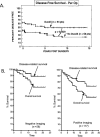Gastrinomas: Medical or Surgical Treatment
- PMID: 30098717
- PMCID: PMC6092039
- DOI: 10.1016/j.ecl.2018.04.009
Gastrinomas: Medical or Surgical Treatment
Abstract
This article reviews the role of surgical and medical management in patients with Zollinger-Ellison syndrome (ZES) due to a gastrin-secreting neuroendocrine tumor (gastrinoma). It concentrates on the status at present but also briefly reviews the changes over time in treatment approaches. Generally, surgical and medical therapy are complementary today; however, in some cases, such as patients with ZES and multiple endocrine neoplasia type 1, the treatment approach remains controversial.
Keywords: Acid secretion; Gastrinoma; Multiple endocrine neoplasia type 1; Neuroendocrine tumor; Proton pump inhibitors; Zollinger-Ellison syndrome.
Published by Elsevier Inc.
Figures






References
-
- Stabile BE. Gastrinoma before Zollinger and Ellison. Am J Surg. 1997;174:232–236. - PubMed
-
- Roy PK, Venzon DJ, Feigenbaum KM, et al. Gastric secretion in Zollinger-Ellison syndrome: correlation with clinical expression, tumor extent and role in diagnosis - A prospective NIH study of 235 patients and review of the literature in 984 cases. Medicine(Baltimore) 2001;80:189–222. - PubMed
-
- Ellison EC, Johnson JA. The Zollinger-Ellison syndrome: a comprehensive review of historical, scientific, and clinical considerations. Curr Probl Surg. 2009;46:13–106. - PubMed
Publication types
MeSH terms
Grants and funding
LinkOut - more resources
Full Text Sources
Other Literature Sources
Medical

